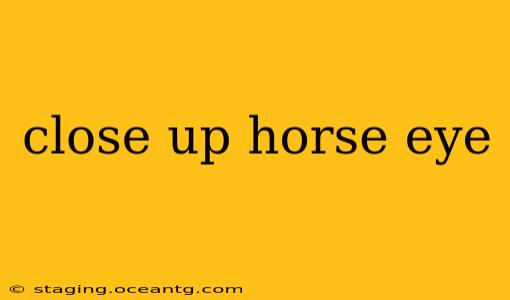A close-up photograph of a horse's eye can be captivating. The sheer size, the intricate details, and the depth of expression make it a compelling subject for photographers and a fascinating study for equine enthusiasts and veterinarians alike. But what can a close-up of a horse's eye actually tell us? This exploration delves into the fascinating world of equine ophthalmology, revealing the secrets held within those expressive orbs.
What Makes a Horse's Eye Unique?
Horses possess remarkably large eyes, relative to their body size. This provides them with a wide field of vision, crucial for their survival in the wild. They have excellent peripheral vision, allowing them to detect movement and potential predators from a distance. However, they have a blind spot directly in front of their nose and a smaller blind spot directly behind them. Understanding this visual limitation is crucial for anyone working with horses. A close-up allows for appreciation of the details: the large, dark pupil that expands and contracts to regulate light intake; the richly colored iris, varying in shades of brown, hazel, and even blue; and the delicate sclera (the white of the eye).
How Can I Tell if a Horse's Eye is Healthy?
A close-up examination can reveal signs of underlying health issues. A healthy horse's eye will be bright and clear, with a moist, transparent conjunctiva (the membrane lining the eyelid). The pupil should be responsive to light, constricting when a bright light is shone on it. Any cloudiness, discharge, redness, or swelling can indicate a problem, ranging from minor irritation to serious conditions.
What are some common eye problems in horses?
Many eye problems can affect horses, including:
- Uveitis: Inflammation of the uvea (the middle layer of the eye). Symptoms may include cloudiness in the eye, pain, and reduced vision.
- Conjunctivitis: Inflammation of the conjunctiva. This is often caused by infection or irritation.
- Corneal ulcers: Open sores on the cornea (the transparent front part of the eye). These can be painful and can lead to blindness if left untreated.
- Cataracts: Clouding of the eye's lens, leading to impaired vision.
- Equine Recurrent Uveitis (ERU): A chronic inflammatory condition affecting the uvea, often causing recurring episodes of inflammation and potential blindness.
Regular veterinary check-ups are vital for detecting any issues early. A close-up examination by a veterinarian using specialized equipment can provide a detailed assessment of the eye's health.
What Does a Horse's Eye Expression Tell Us?
Beyond physical health, a close-up of a horse's eye offers a glimpse into its emotional state. The subtle changes in pupil size, the position of the eyelids, and the overall expression can convey a wide range of emotions, from fear and anxiety to contentment and trust. Experienced horse handlers can often read these cues to better understand their horses' needs and feelings. While not a definitive science, observing a horse's eye closely is a crucial component of building a strong relationship based on understanding and empathy.
How can I tell what my horse is feeling based on its eyes?
While not an exact science, certain observations can be suggestive:
- Wide eyes and dilated pupils: May indicate fear, alertness, or excitement.
- Narrowed eyes and constricted pupils: May suggest contentment or relaxation.
- Rolling eyes: Often an indicator of discomfort or pain.
- Cloudy or dull eyes: Can be a sign of illness or fatigue.
However, it's vital to always consider the context of the horse's overall behaviour and body language, as eye expressions alone may not provide a complete picture.
Why are close-up horse eye photos so popular?
The popularity of close-up horse eye photographs stems from the captivating beauty and expressiveness of these majestic animals. The detail, combined with the emotional depth that the eyes can convey, makes them a compelling subject for artistic expression and scientific observation alike. They are often used to evoke powerful emotions in viewers and communicate the beauty and connection between humans and animals. The intricate patterns of the iris, combined with the reflective quality of the eye itself, creates a visually stunning image.
By combining an understanding of equine ophthalmology with an appreciation of equine behavior, we can unlock a deeper understanding of these magnificent animals through the seemingly simple, yet profoundly expressive, close-up of a horse's eye.
